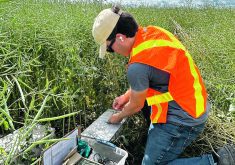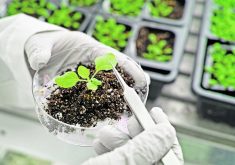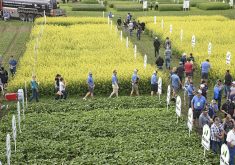VANCOUVER – Faulty testing is one of the reasons the Canadian flax industry considers the European Union’s 0.01 percent tolerance level for Triffid contamination unworkable.
The tests are so sensitive and the contamination levels so tiny that the test can sometimes indicate presence of Triffid even when it is not there. This is called a false positive.
Researchers at the University of Sask atchewan have determined there is a 0.6 percent chance of generating a false positive using the current Triffid test. The number of false positives rises in conjunction with the number of times a sample is tested.
Read Also

Message to provincial agriculture ministers: focus on international trade
International trade stakeholders said securing markets in the face of increasing protectionism should be the key priority for Canada’s agriculture ministers.
“A clean lot tested four times has a 2.4 percent chance of coming back positive,” said Eric Lamb, assistant professor in the university’s plant sciences department.
That raises an interesting question about how much Triffid is in the Canadian system.
“Do we really have a low level presence problem or do we have an inaccurate test problem?” said Lamb.
He has compared the results of the 2011 Triffid testing program with the number of false positives he would expect given the testing flaws.
The comparison suggests there is likely still Triffid contamination in farm saved seed, production seed and rail car seed.
However, the amount of positives in the pedigreed seed supply is well within the range of what would be expected given the potential for false positives.
“This is probably a pretty darn good indication that the certified seed is GM free,” said Lamb.
The amount of positives in terminal bins at the Port of Thunder Bay is also within the expected range.
“Here we’ve got some evidence that the testing efforts are actually working,” said Lamb.
Flax Council of Canada president Will Hill said there has been progress. Two percent of producer stocks have tested positive for Triffid this year compared to 10 percent in 2009-10.
Contamination of farm saved and pedigreed seed is three and zero percent respectively, down from 14 and seven percent in 2009-10.
Helen Booker, a flax breeder at the U of S, said false positives forced the university’s Crop Development Centre to reconstitute CDC Bethune and CDC Sorrel, the two main flax varieties.
Breeder seed lots were tested up to 85 times, increasing the probability of generating a false positive to 40 percent. That meant there was no way of knowing if the seed was clean.
So the university created plants from remnant seed, tissue tested the plants for GM material to ensure they had none and sent them to GM-free New Zealand for reproduction.
“Our hope is that by early 2014 there will be new certified seed there for farmers to purchase and this will flush out the system as best we can,” said Booker.
The work at the university demonstrates that countries need to start adopting low level presence policies that allow for a reasonable level of contamination.
“The testing limitations make zero tolerance policies impossible to manage and impossible targets to meet, so there is some need for some low level acceptance between trading nations for unapproved events.”














